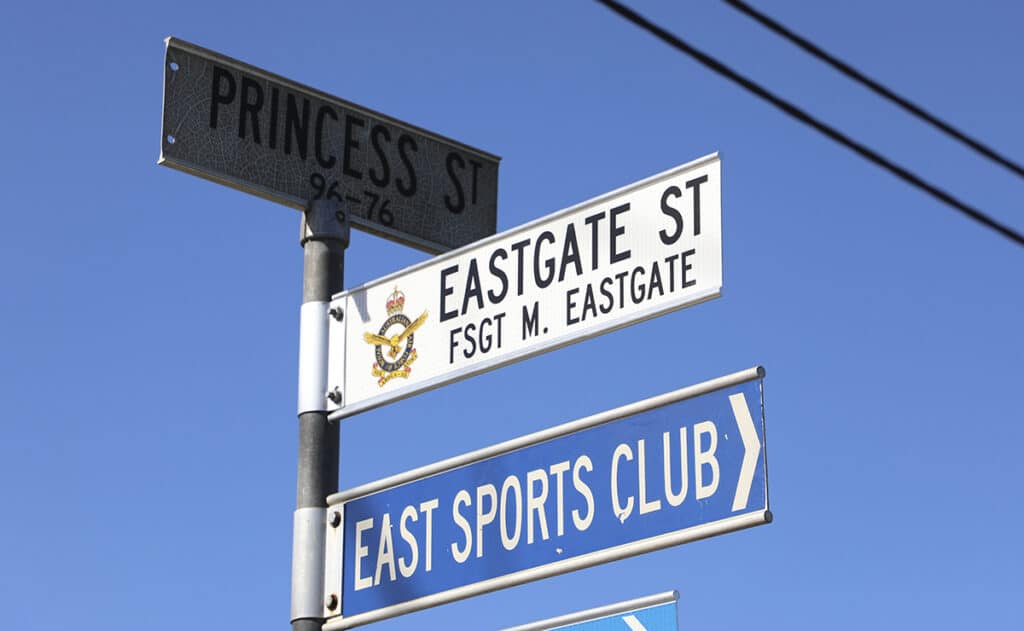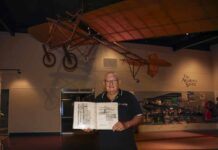
Flight Sergeant Mervyn Louis Eastgate has been honoured through Council’s Streets of Remembrance program after he was killed in action during World War II.
After growing up and attending school in Bundaberg, Flight Sergeant Eastgate became one of almost 16,000 pilots, navigators, wireless operators, gunners, and engineers who joined Royal Australian Air Force squadrons throughout the course of the war.
The Streets of Remembrance program sees the badge under which local veterans served added to the signs of Bundaberg Region streets named their honour.
To date 37 veterans have been honoured through existing streets and a further 14 have been approved for future street naming, with another 20 still under investigation.
One of those streets is Eastgate Street, Bundaberg East.
Australian War Memorial Historian, Military History Section, Dr Lachlan Grant prepared the following speech delivered at a Last Post Ceremony on 29 March 2016 that shared the story of the bravery Flight Sergeant Eastgate:
Today we pay tribute to Flight Sergeant Mervyn Louis Eastgate, who was killed on active service with the Royal Air Force.
Born in Bundaberg, Queensland, on 4 November 1919, Mervyn Eastgate was one of five children born to William and Alice Eastgate.
Along with his siblings – Stanley, William, Harry and Beryl – Mervyn attended the East Bundaberg Primary School and then Bundaberg High School.
A keen sportsman during his youth, he enjoyed tennis, football, cricket, golf, and swimming.
He left school at 15 and worked as clerk for the Bank of New South Wales.
On 3 March 1941 he enlisted in the Royal Australian Air Force and began training as a wireless officer.
He was quickly promoted to leading aircraftman and then sergeant.
In November 1941 Eastgate embarked in Sydney for overseas service.
As part of the Empire Air Training Scheme, Eastgate was one of almost 16,000 RAAF pilots, navigators, wireless operators, gunners, and engineers who joined Royal Air Force squadrons throughout the course of the war.
Arriving in Rhodesia, Eastgate undertook further specialist training and was promoted to flight sergeant before joining No. 233 Squadron, Royal Air Force, in the Middle East in September 1942.
Based in Egypt, the squadron flew the Martin Baltimore twin-engine bomber and provided support for the British Eighth Army.
There, Eastgate joined a crew of three British airmen.
On 3 April 1943 No. 233 Squadron was conducting a raid over Tunisia when the Baltimore in which Eastgate was flying was hit by anti-aircraft fire.
The pilot and co-pilot managed to parachute safely to the ground, where they were captured as prisoners of war, but Eastgate and the air gunner were killed in action.
The men were buried side by side in a joint grave in the Medjez-El-Bab British and Commonwealth War Cemetery in Tunisia.
Mervyn Eastgate was 23 years old.
His name is listed on the Roll of Honour on my left, among some 40,000 other Australians who died while serving in the Second World War.
This is but one of the many stories of service and sacrifice told here at the Australian War Memorial.
We now remember Flight Sergeant Mervyn Louis Eastgate, who gave his life for us, for our freedoms, and in the hope of a better world.
Read the speech transcript and view the recording of its reading on the Australian War Memorial website here.







